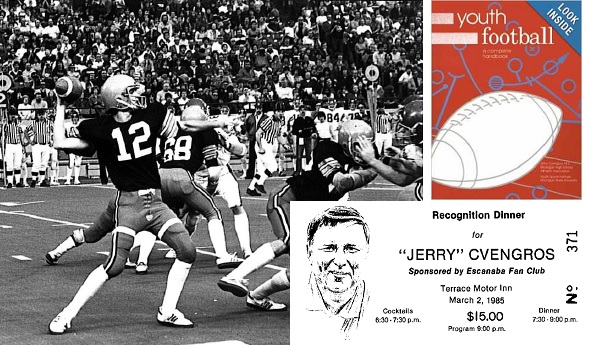
MHSAA Fall Practices to Begin with Common Start Date, Return of Traditional Schedules & Formats
By
Geoff Kimmerly
MHSAA.com senior editor
August 6, 2021
Teams participating in all nine sports for which the Michigan High School Athletic Association sponsors postseason tournaments – featuring more than 100,000 student athletes statewide – will be allowed to begin practice Monday, Aug. 9, and with a return to traditional schedules and MHSAA Tournament formats after COVID-19 resulted in various adjustments for the Fall 2020 season.
Postseason competition in cross country, football, golf, tennis and swimming & diving will revert to their customary formats this season, with all fall sports scheduled based on their traditional calendars other than beginning practice with a common start date for the first time. At the time of this release, there are no COVID-19-related state-ordered restrictions regarding school sports, for either athletes or spectators, from either the MHSAA or the Michigan Department of Health & Human Services (MDHHS). County health departments and local school districts may institute restrictions for venues in their areas, and teams traveling to those schools and venues must follow local mandates.
For most of the MHSAA’s modern history, football teams had begun practice Monday of the first week of the preseason, followed by the rest of fall teams two days later. A 2019 rule change allowed a few more sports to begin on Monday, dependent on their Finals dates that fall. The common start date for all fall practices this season and annually moving forward was approved by the MHSAA Representative Council at its Spring Meeting in May and allows all teams to begin the 16th Monday before Thanksgiving.
Football teams still must have 12 days of preseason practice at all levels before their first game, over a period of 16 calendar days before the first kickoff, with the first varsity games this fall scheduled for Aug. 26 and the weekend of Aug. 27-28. Competition this fall may begin Aug. 16 for golf and tennis teams and Aug. 18 in cross country, soccer, volleyball and swimming & diving.
One of the most anticipated sport-related changes for Fall 2021 is the full implementation of the “enhanced strength-of-schedule” format for selecting the 256-team field for the 11-Player Football Playoffs. The new format eliminates automatic qualification based on win total and bases it solely on playoff-point average, which also is determined differently in that it now awards teams more for playing tougher schedules. (Click for a more detailed comparison of the previous and new formats.)
The new playoff-point formula was used in 2020 to seed teams at the District and Regional levels, but its use for qualification was put on hold as COVID-19 caused a one-season switch in playoff format that allowed all teams to qualify.
Additional rules changes in cross country, football, golf and tennis will be most noticeable this fall:
• Cross Country will provide an opportunity for more individual Finals qualifiers this season, as a minimum of seven individual qualifiers will advance from each Regional race. Previously, runners on teams that did not qualify as a whole could still advance to the Finals if they finished among the top 15 individuals at a Regional – but at some Regionals runners from the team qualifiers filled the great majority of those top 15 finishes. The seven individual qualifiers from each Regional this season will be the first seven finishers from teams that do not qualify as a whole, even if they finish outside of the top 15.
• Another football change continues the focus on minimizing injury risk, addressing blocking below the waist in the free-blocking zone (the rectangular area extending laterally four yards to either side of the snap and three behind the line of scrimmage). The new rule states a below-the-waist block in the free-blocking zone must occur as an immediate, initial action following the snap, instead of the previous rule which allowed an offensive lineman to delay and block below the waist as long as the ball was still in the zone.
• For Lower Peninsula girls golf, teams will be required to use the scoring platform iWanamaker also for the regular season, just as they were required to do so for MHSAA Tournament competition during the 2020-21 school year. The scoring platform is made available through the MHSAA Golf app, which was created and is operated by iWanamaker and allows golfers, coaches and fans to chart scoring in real time.
• In tennis, if a seeded player withdraws on the day of an MHSAA Regional or Final, all seeded players below that withdrawing player (including the provisional seed in that flight) will move up and be placed on the proper line for that new seed. (Non-seeded players drawn into the bracket will not be moved.)
The 2021 Fall campaign culminates with postseason tournaments beginning with the Upper Peninsula Girls Tennis Finals during the final week of September and wraps up with the 11-Player Football Finals on Nov. 26 and 27. Here is a complete list of fall tournament dates:
Cross Country
U.P. Finals – Oct. 23
L.P. Regionals – Oct. 29 or 30
L.P. Finals – Nov. 6
11-Player Football
Selection Sunday – Oct. 24
Pre-Districts – Oct. 29 or 30
District Finals – Nov. 5 or 6
Regional Finals – Nov. 12 or 13
Semifinals – Nov. 20
Finals – Nov. 26-27
8-Player Football
Selection Sunday – Oct. 24
Regional Semifinals – Oct. 29 or 30
Regional Finals – Nov. 5 or 6
Semifinals – Nov. 13
Finals – Nov. 19 or 20
L.P. Girls Golf
Regionals – Oct. 4, 5, 6, 7, 8, or 9
Finals – Oct. 15-16
Soccer
Boys L.P. Districts – Oct. 13-23
Boys L.P. Regionals – Oct. 26-30
Boys L.P. Semifinals – Nov. 3 Boys
L.P. Finals – Nov. 6
L.P. Girls Swimming & Diving
Diving Regionals – Nov. 11
Swimming/Diving Finals – Nov. 19-20
Tennis
U.P. Girls Finals – Sept. 29, 30, Oct. 1, or 2
L.P. Boys Regionals – Oct. 6, 7, 8 or 9
L.P. Finals – Oct. 14-16
Girls Volleyball
Districts – Nov. 1-6
Regionals – Nov. 9 &11
Quarterfinals – Nov. 16
Semifinals – Nov. 18-19
Finals – Nov. 20
The MHSAA is a private, not-for-profit corporation of voluntary membership by more than 1,500 public and private senior high schools and junior high/middle schools which exists to develop common rules for athletic eligibility and competition. No government funds or tax dollars support the MHSAA, which was the first such association nationally to not accept membership dues or tournament entry fees from schools. Member schools which enforce these rules are permitted to participate in MHSAA tournaments, which attract more than 1.4 million spectators each year.

Cvengros Leaves Lasting Impact
By
Geoff Kimmerly
MHSAA.com senior editor
April 1, 2014
Retired Associate Director Jerry Cvengros, who served at the Michigan High School Athletic Association for more than 13 years after three decades at Escanaba High School, died Monday evening in Lansing. He was 80.
As lead assistant to Executive Director John E. “Jack” Roberts from August 1988 until retiring in January 2002, Cvengros served as director of football and briefly hockey in addition to coordinating the Program of Athletic Coaches Education (PACE), presenting annual in-service training for administrators and serving as MHSAA liaison to statewide principals, athletic directors and coaches associations.
 He came to the MHSAA after 30 years at Escanaba, where he taught, coached, served as athletic director and later principal during a tenure stretching from August 1958 through July 1988. While at Escanaba, Cvengros also represented Upper Peninsula Class A and B schools on the MHSAA Representative Council from 1983-88 and served as the Council’s president from 1986-88.
He came to the MHSAA after 30 years at Escanaba, where he taught, coached, served as athletic director and later principal during a tenure stretching from August 1958 through July 1988. While at Escanaba, Cvengros also represented Upper Peninsula Class A and B schools on the MHSAA Representative Council from 1983-88 and served as the Council’s president from 1986-88.
Cvengros received the MHSAA’s Charles E. Forsythe Award in 2000 in recognition of his many and significant contributions to interscholastic athletics.
“During his lifetime, Jerry Cvengros impacted every area of interscholastic athletics as a coach, athletic director, principal and then associate director of the MHSAA," Roberts said. “He was the perfect combination of fairness, toughness and diplomacy, able to draw on a vast knowledge of MHSAA rules and an understanding of educational athletics fostered by his various experiences.
“Jerry was known and respected statewide for his dedication, and his contributions have had a lasting impact.”
Cvengros built an elite football program at Escanaba as varsity head coach from 1962-84, leading the Eskymos to a 161-42-3 record, a Class A runner-up finish in 1979 and the MHSAA championship in 1981. That team remains the only Class A/Division 1 team from the Upper Peninsula to win an MHSAA football title. Cvengros was inducted into the Michigan High School Football Coaches Association Hall of Fame and served on its original Board of Directors.
His 1979 team fell to Detroit Catholic Central 32-7, but he brought the Eskymos back to the Finals for a 16-6 win over Fraser two seasons later. Cvengros' championship lineup included quarterback Kevin Tapani, who would go on to pitch for the Minnesota Twins among five major league clubs, and tailback Dean Altobelli, who later played at Michigan State University. The title run included a 15-14 Semifinal win over Dearborn Fordson that included a savvy two-point conversion call by Cvengros, who wanted to avoid overtime after a late score drew Escanaba to within a point of tying the score.
As the MHSAA’s director of football, Cvengros was instrumental in creating the current playoff format that expanded the field from 128 to 256 teams beginning with the 1999 season. He also co-authored “Youth Football: A Complete Handbook,” a guide to coaching at that level.
Among many additional honors, Cvengros was inducted into the Upper Peninsula Sports Hall of Fame and Michigan High School Coaches Association Hall of Fame and received the Distinguished Service Award from the Michigan Interscholastic Athletic Administrators Association. The National Federation of State High School Associations twice awarded Cvengros with a Citation – the NFHS’ highest honor – for his service as a coach and then as a member of the MHSAA staff.
Since his retirement, Cvengros and his wife Shelley have continued to reside in Okemos. A visitation will take place beginning at 10 a.m. Monday, April 7, at St. Martha Parish in Okemos, with a funeral Mass to follow at 11 a.m.
Cvengros was a 1951 graduate of Ironwood High School and went on to study and play football at the University of Wisconsin in Madison. He earned his bachelor’s degree in secondary education and teaching from the University of Wisconsin-Superior and a master’s from Northern Michigan University.
He taught English, history and physical education at Escanaba High School and also coached basketball and track and field. He became the school’s athletic director in 1970, added the duties of activities director in 1975 and became principal in 1983.
Cvengros is survived by his wife and children Michael, Steven and David, and seven grandchildren. He was preceded in death by his daughter Lee Ann (Cvengros) Swasey in May 2013.
PHOTOS: (Clockwise from left) Escanaba quarterback Mike Beveridge fires a pass during the 1979 Class A Final; Cvengros co-authored a book on coaching youth football; Cvengros was celebrated once more in Escanaba following his final season as football coach.

